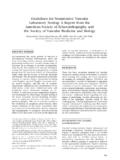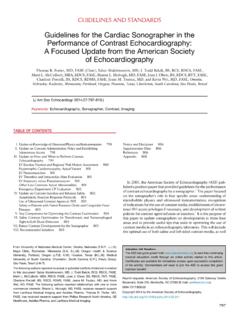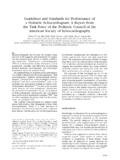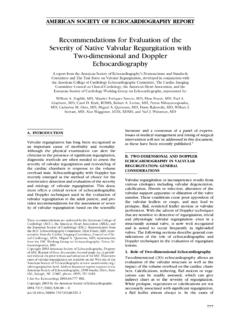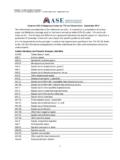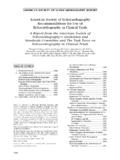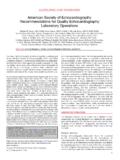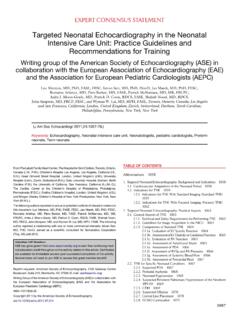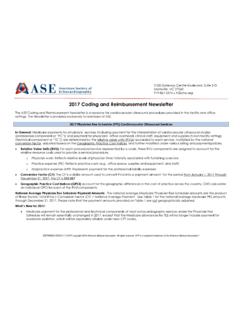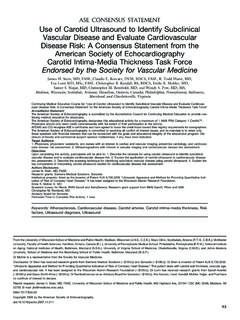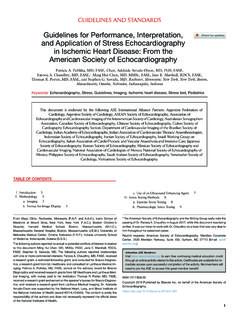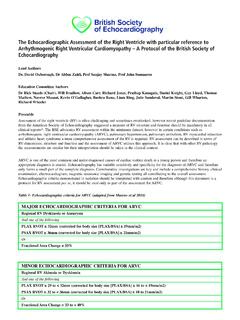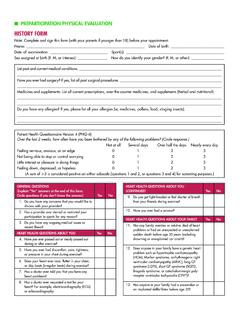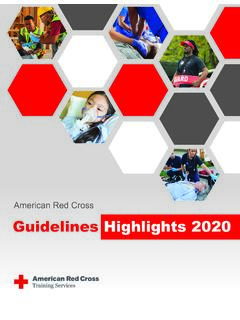Transcription of AMERICAN SOCIETY OF ECHOCARDIOGRAPHY
1 AMERICAN SOCIETY OF ECHOCARDIOGRAPHY RECOMMENDATIONS FOR A STANDARDIZED REPORT FOR ADULT TRANSTHORACIC ECHOCARDIOGRAPHY From the AMERICAN SOCIETY of ECHOCARDIOGRAPHY s Nomenclature and Standards Committee and Task Force for a Standardized ECHOCARDIOGRAPHY Report represented by Julius M. Gardin, MD, David B. Adams, RDCS, Pamela S. Douglas, MD, Harvey Feigenbaum, MD, David H. Forst, MD, Alan G. Fraser, MD, Paul A. Grayburn, MD, Alan S. Katz, MD, Andrew M. Keller, MD, Richard E. Kerber, MD, Bijoy K. Khandheria, MD, Allan L. Klein, MD, Roberto M. Lang, MD, Luc A. Pierard, MD, Miguel A. Quinones, MD, Ingela Schnittger, MD The AMERICAN SOCIETY of ECHOCARDIOGRAPHY has published guidelines relating to standards for training (and certification); performance; nomenclature and measurement; and quality improvement related to However, the SOCIETY has not previously made recommendations about what constitutes the core variables , measurements and other elements to be included in a transthoracic echocardiographic report.
2 A document addressing this topic would be timely and could serve the following purposes: 1) Promote quality by defining the basic core of measurements and statements which constitute the report, 2) Encourage the comparison of serial echocardiograms performed in patients at the same site or different sites, 3) Improve communication by expediting development of structured report form software, and 4) Facilitate multicenter research and analyses of cost-effectiveness. Because of these considerations, Dr. Richard Kerber, President of the AMERICAN SOCIETY of ECHOCARDIOGRAPHY , appointed a task force in 1998 to develop recommendations for a standardized report for adult ECHOCARDIOGRAPHY . Various international societies have recently addressed this issue and recommended standards.
3 The purpose of this report is not to define how to record a proper adult cardiac ultrasound examination or how to perform the measurements but, rather, to serve as a guideline to what measurements and descriptive items should be included. It is the hope of the Task Force that publication of this document will further our ongoing efforts to improve the overall quality of the practice of ECHOCARDIOGRAPHY . REPORT FORMAT The adult transthoracic ECHOCARDIOGRAPHY report should be comprised of the following sections: 1) Demographic and other Identifying Information, 2) Echocardiographic (Doppler, if indicated) Evaluation, and 3) Summary. These sections will be outlined briefly below. The Task Force believes that there must be some latitude regarding the precise format of the ECHOCARDIOGRAPHY report so long as it contains this basic information.
4 For example, some laboratories may wish to use a graphic display of LV regional wall motion, whereas others may choose a text format for reporting this information. When possible, this information should be coded in database format to facilitate retrieval and communication. 2 Ideally, when Doppler descriptive information is included, it should be integrated with the corresponding statements derived from echocardiographic images. For example, descriptive statements regarding a regurgitant prosthetic mitral valve derived from both echocardiographic imaging and Doppler examinations should be grouped together. However, some laboratories may prefer to group all the Doppler data under a separate section of the report.
5 This is acceptable as long as the pertinent information is available. Demographic and Other Identifying Information It is suggested that the ECHOCARDIOGRAPHY report include the following demographic and other identifying information: (1) Patient s name and/or other unique identifier, (2) Age, (3) Gender, (4) Indications for test, (5) Height, (6) Weight, (7) Blood pressure (if available), (8) Referring physician identification, (9) Interpreting physician identification, and (10) Date on which study was performed. Other identifying information which may be helpful includes: (1) Echo study media location ( , disk or tape number, etc), (2) Date on which the study was ordered, read, transcribed if applicable, and verified, (3) Location of the patient ( , outpatient, inpatient, etc.)
6 , (4) Location where study was performed, (5) Name or identifying information for person(s) performing the study ( , sonographer, physician), (6) Echo instrument identification, and (7) Imaging views obtained, or not obtained-especially if the study is suboptimal. Echocardiographic and Doppler Evaluation A. CARDIAC STRUCTURES The following cardiac and vascular structures are generally be evaluated as part of a comprehensive adult transthoracic ECHOCARDIOGRAPHY report: 1) Left Ventricle 2) Left Atrium 3) Right Atrium 4) Right Ventricle 5) Aortic Valve 6) Mitral Valve 7) Tricuspid Valve 8) Pulmonic Valve 9) Pericardium 10) Aorta 11) Pulmonary Artery 12) Inferior Vena Cava and Pulmonary Veins It should be emphasized that identification and measurement of some of the structures listed may not always be possible or necessary to provide a comprehensive, clinically relevant report.
7 However it is important for the ECHOCARDIOGRAPHY report to include comments on the left ventricle, left atrium, mitral valve and aortic valve. When images of these structures cannot be recorded or interpreted, the report should state that imaging was suboptimal or impossible. In addition, the indication for a particular echocardiographic study may make it crucial to image a particular anatomic structure or to obtain specific 3 Doppler recording(s). In this case, it is important for the report to comment on the crucial findings or to note that an adequate recording was not possible. B. MEASUREMENTS As a general rule, quantitative measurements are preferable.
8 However, it is recognized that qualitative or semi-quantitative assessments are often performed and frequently adequate. The following types of measurements are commonly included in a comprehensive ECHOCARDIOGRAPHY report. 1) Left Ventricle: a) Size: Dimensions or volumes, at end-systole and end-diastole b) Wall thickness and/or mass: Ventricular septum and left ventricular posterior wall thicknesses (at end-systole and end-diastole) and/or mass (at end-diastole) c) Function: Assessment of systolic function and regional wall motion. Assessment of diastolic function 2) Left Atrium: Size: Area or dimension 3) Aortic Root: Dimension 4) Valvular Stenosis: a) For Valvular Stenosis: Assessment of severity.
9 Measurements that provide an accurate assessment of severity include trans-valvular gradient and area. b) For Subvalvular Stenosis: Assessment of severity. Measurement of subvalvular gradient provides the most accurate assessment of severity and is, therefore, recommended. 5) Valvular Regurgitation: Assessment of severity with semi-quantitative descriptive statements and/or quantitative measurements 6) Prosthetic Valves: a) Transvalvular gradient and effective orifice area b) Description of regurgitation, if present 7) Cardiac Shunts: Assessment of severity. Measurements of QP:QS (pulmonary-to-systemic flow ratio) and/or orifice area or diameter of the defect are often helpful. C. DESCRIPTIVE STATEMENTS Descriptive statements that echocardiographers may choose to use to describe pertinent findings are listed in the Appendix.
10 These descriptive statements are broad in scope, but not all-inclusive, and are provided as an illustrative guide. Since these statements represent the universe of possible findings, they are not intended to be included in any single report. Rather, a carefully selected subset of these statements should be included in each report, balancing the needs for conciseness and completeness in responding to the patient s and referring physician s needs. Laboratories may choose to adapt these brief statements to construct sentences for use in this section of the report or in the Summary. 4 Summary A summary of the echocardiographic report often includes statements that: 1) Answer the question(s) posed by the referring physician, 2) Emphasize abnormal findings, and 3) Compare important differences and similarities of the current study versus previous echocardiographic studies, or reports, if available and deemed clinically relevant.
